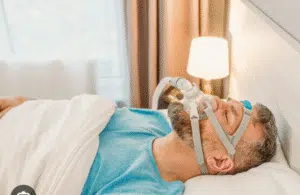Obstructive Sleep Apnea Treatment is one of the most common yet underdiagnosed sleep disorders. Many people experience symptoms like loud snoring, pauses in breathing, or daytime fatigue, but don’t realize they may have OSA.
The good news? With the right diagnosis and treatment—often involving a CPAP machine—OSA can be effectively managed. In this blog, we’ll walk you through the OSA treatment journey, from the first signs and diagnosis to proven treatment options.

Recognizing the Symptoms of OSA
The OSA journey begins with awareness. Common symptoms include:
-
Loud, chronic snoring
-
Choking or gasping during sleep
-
Morning headaches
-
Daytime sleepiness and fatigue
-
Difficulty concentrating
If these symptoms sound familiar, it’s time to see a doctor or sleep specialist.
Getting Diagnosed with OSA
A proper diagnosis is essential before starting treatment. There are two main types of tests:
-
In-Lab Sleep Study (Polysomnography)
-
Conducted in a sleep clinic
-
Measures brain waves, breathing, oxygen, and sleep stages
-
Gold standard for diagnosing OSA and other sleep disorders
-
-
Home Sleep Test (HST)
-
Conducted in the comfort of your home
-
Uses a portable device to measure breathing and oxygen levels
-
Convenient and more affordable, best for suspected OSA
-
Exploring OSA Treatment Options
Once diagnosed, your doctor will discuss the best OSA treatment options:
1. CPAP Therapy (Gold Standard)
-
CPAP = Continuous Positive Airway Pressure
-
Keeps your airway open with a steady stream of air
-
Most effective treatment for moderate to severe OSA
2. BiPAP Therapy
-
BiPAP = Bilevel Positive Airway Pressure
-
Provides different pressures for inhaling and exhaling
-
Recommended for patients who struggle with CPAP or have complex breathing issues
3. Lifestyle Changes
-
Weight management
-
Avoiding alcohol before bedtime
-
Sleeping on your side
-
Regular exercise
These changes can reduce OSA severity but are usually combined with CPAP therapy.
4. Oral Appliances
-
Custom dental devices that reposition the jaw
-
Suitable for mild OSA or people intolerant of CPAP
5. Surgery
-
Options like UPPP (uvulopalatopharyngoplasty) or Inspire implant
-
Considered only for patients who fail CPAP or other therapies
Step 4: Living with a Sleep Apnea Machine
For most patients, a CPAP machine becomes part of daily life. Adjusting to therapy takes time, but modern devices are:
-
Quieter
-
More comfortable (with heated humidifiers and soft masks)
-
Equipped with smart technology for tracking progress
With consistent use, patients often experience:
-
Better sleep quality
-
Improved energy levels
-
Reduced risk of heart problems and high blood pressure
FAQs About OSA Treatment
Q1. What are the main treatment options for OSA?
CPAP therapy, lifestyle changes, oral appliances, surgery, and BiPAP for complex cases.
Q2. Do all patients with OSA need a CPAP machine?
Not all, but CPAP is the gold standard for moderate to severe OSA. Mild cases may try oral appliances or lifestyle changes.
Q3. Can OSA be cured naturally?
Weight loss and lifestyle changes can improve OSA, but most patients still require CPAP or another treatment.
Q4. What happens if OSA is left untreated?
Untreated OSA increases risks of heart disease, high blood pressure, stroke, and accidents due to fatigue.
Q5. Is BiPAP better than CPAP?
BiPAP is recommended for specific cases, but CPAP remains the first-line treatment for most patients.
